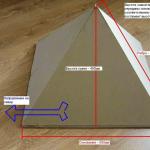- 22.09.2014
Operating principle. When you press the button of the first digit of the SA1 code, the DD1.1 trigger will switch and a high level voltage will appear at the D input of the DD1.2 trigger. Therefore, when you press the next SA2 code button, trigger DD1.2 changes its state and prepares the next trigger for switching. In case of further correct dialing, trigger DD2.2 will be triggered last, and...
- 03.10.2014
The proposed device stabilizes voltage up to 24V and current up to 2A with short circuit protection. In case of unstable startup of the stabilizer, synchronization from an autonomous pulse generator should be used (Fig. 2. The stabilizer circuit is shown in Fig. 1. A Schmitt trigger is assembled on VT1 VT2, which controls a powerful regulating transistor VT3. Details: VT3 is equipped with a heat sink...
- 20.09.2014
The amplifier (see photo) is made according to a traditional circuit with auto-biasing tubes: output - AL5, drivers - 6G7, kenotron - AZ1. The diagram of one of the two channels of a stereo amplifier is shown in Fig. 1. From the volume control, the signal is supplied to the grid of the 6G7 lamp, amplified, and from the anode of this lamp through the isolation capacitor C4 is supplied to ...
- 15.11.2017
NE555 is a universal timer - a device for forming (generating) single and repeating pulses with stable time characteristics. It is an asynchronous RS trigger with specific input thresholds, precisely defined analog comparators and a built-in voltage divider (precision Schmitt trigger with RS trigger). It is used to build various generators, modulators, time relays, threshold devices and other...
The ability to calculate the volume of spatial figures is important when solving a number of practical problems in geometry. One of the most common figures is the pyramid. In this article we will consider both full and truncated pyramids.
Pyramid as a three-dimensional figure
Everyone knows about the Egyptian pyramids, so they have a good idea of what kind of figure we will be talking about. However, Egyptian stone structures are only a special case of a huge class of pyramids.
The geometric object under consideration in the general case is a polygonal base, each vertex of which is connected to a certain point in space that does not belong to the plane of the base. This definition leads to a figure consisting of one n-gon and n triangles.
Any pyramid consists of n+1 faces, 2*n edges and n+1 vertices. Since the figure in question is a perfect polyhedron, the numbers of marked elements obey Euler’s equality:
2*n = (n+1) + (n+1) - 2.
The polygon located at the base gives the name of the pyramid, for example, triangular, pentagonal, and so on. A set of pyramids with different bases is shown in the photo below.
The point at which n triangles of a figure meet is called the vertex of the pyramid. If a perpendicular is lowered from it onto the base and it intersects it at the geometric center, then such a figure will be called a straight line. If this condition is not met, then an inclined pyramid occurs.
A right figure whose base is formed by an equilateral (equiangular) n-gon is called regular.
Formula for the volume of a pyramid
To calculate the volume of the pyramid, we will use integral calculus. To do this, we divide the figure by cutting planes parallel to the base into an infinite number of thin layers. The figure below shows a quadrangular pyramid of height h and side length L, in which the quadrilateral marks the thin layer of the section.

The area of each such layer can be calculated using the formula:
A(z) = A 0 *(h-z) 2 /h 2 .
Here A 0 is the area of the base, z is the value of the vertical coordinate. It can be seen that if z = 0, then the formula gives the value A 0 .
To obtain the formula for the volume of a pyramid, you should calculate the integral over the entire height of the figure, that is:
V = ∫ h 0 (A(z)*dz).
Substituting the dependence A(z) and calculating the antiderivative, we arrive at the expression:
V = -A 0 *(h-z) 3 /(3*h 2)| h 0 = 1/3*A 0 *h.
We have obtained the formula for the volume of a pyramid. To find the value of V, just multiply the height of the figure by the area of the base, and then divide the result by three.
Note that the resulting expression is valid for calculating the volume of a pyramid of any type. That is, it can be inclined, and its base can be an arbitrary n-gon.
and its volume
The general formula for volume obtained in the paragraph above can be refined in the case of a pyramid with a regular base. The area of such a base is calculated using the following formula:
A 0 = n/4*L 2 *ctg(pi/n).
Here L is the side length of a regular polygon with n vertices. The symbol pi is the number pi.
Substituting the expression for A 0 into the general formula, we obtain the volume of a regular pyramid:
V n = 1/3*n/4*L 2 *h*ctg(pi/n) = n/12*L 2 *h*ctg(pi/n).
For example, for a triangular pyramid, this formula results in the following expression:
V 3 = 3/12*L 2 *h*ctg(60 o) = √3/12*L 2 *h.
For a regular quadrangular pyramid, the volume formula takes the form:
V 4 = 4/12*L 2 *h*ctg(45 o) = 1/3*L 2 *h.
Determining the volumes of regular pyramids requires knowledge of the side of their base and the height of the figure.
Truncated pyramid
Let's assume that we took an arbitrary pyramid and cut off part of its lateral surface containing the vertex. The remaining figure is called a truncated pyramid. It already consists of two n-gonal bases and n trapezoids that connect them. If the cutting plane was parallel to the base of the figure, then a truncated pyramid is formed with similar parallel bases. That is, the lengths of the sides of one of them can be obtained by multiplying the lengths of the other by a certain coefficient k.

The figure above shows a truncated regular one. It can be seen that its upper base, like the lower one, is formed by a regular hexagon.
The formula that can be derived using integral calculus similar to the one above is:
V = 1/3*h*(A 0 + A 1 + √(A 0 *A 1)).
Where A 0 and A 1 are the areas of the lower (large) and upper (small) bases, respectively. The variable h denotes the height of the truncated pyramid.
Volume of the Cheops pyramid

It is interesting to solve the problem of determining the volume that the largest Egyptian pyramid contains inside itself.
In 1984, British Egyptologists Mark Lehner and Jon Goodman established the exact dimensions of the Cheops pyramid. Its original height was 146.50 meters (currently about 137 meters). The average length of each of the four sides of the structure was 230.363 meters. The base of the pyramid is square with high precision.
Let us use the given figures to determine the volume of this stone giant. Since the pyramid is regular quadrangular, then the formula is valid for it:
Substituting the numbers, we get:
V 4 = 1/3*(230.363) 2 *146.5 ≈ 2591444 m 3.
The volume of the Cheops pyramid is almost 2.6 million m3. For comparison, we note that the Olympic swimming pool has a volume of 2.5 thousand m 3. That is, to fill the entire Cheops pyramid you will need more than 1000 such pools!
is a polyhedron that is formed by the base of the pyramid and a section parallel to it. We can say that a truncated pyramid is a pyramid with the top cut off. This figure has many unique properties:
- The lateral faces of the pyramid are trapezoids;
- The lateral edges of a regular truncated pyramid are of the same length and inclined to the base at the same angle;
- The bases are similar polygons;
- In a regular truncated pyramid, the faces are identical isosceles trapezoids, the area of which is equal. They are also inclined to the base at one angle.
The formula for the lateral surface area of a truncated pyramid is the sum of the areas of its sides: ![]()
Since the sides of a truncated pyramid are trapezoids, to calculate the parameters you will have to use the formula trapezoid area. For a regular truncated pyramid, you can apply a different formula for calculating the area. Since all its sides, faces, and angles at the base are equal, it is possible to apply the perimeters of the base and the apothem, and also derive the area through the angle at the base.
If, according to the conditions in a regular truncated pyramid, the apothem (height of the side) and the lengths of the sides of the base are given, then the area can be calculated through the half-product of the sum of the perimeters of the bases and the apothem:

Let's look at an example of calculating the lateral surface area of a truncated pyramid.
Given a regular pentagonal pyramid. Apothem l= 5 cm, the length of the edge in the large base is a= 6 cm, and the edge is at the smaller base b= 4 cm. Calculate the area of the truncated pyramid.
First, let's find the perimeters of the bases. Since we are given a pentagonal pyramid, we understand that the bases are pentagons. This means that the bases contain a figure with five identical sides. Let's find the perimeter of the larger base:
In the same way we find the perimeter of the smaller base:
Now we can calculate the area of a regular truncated pyramid. Substitute the data into the formula:
Thus, we calculated the area of a regular truncated pyramid through the perimeters and apothem.
Another way to calculate the lateral surface area of a regular pyramid is the formula through the angles at the base and the area of these very bases.

Let's look at an example calculation. We remember that this formula applies only to a regular truncated pyramid.
Let a regular quadrangular pyramid be given. The edge of the lower base is a = 6 cm, and the edge of the upper base is b = 4 cm. The dihedral angle at the base is β = 60°. Find the lateral surface area of a regular truncated pyramid.
First, let's calculate the area of the bases. Since the pyramid is regular, all the edges of the bases are equal to each other. Considering that the base is a quadrilateral, we understand that it will be necessary to calculate area of the square. It is the product of width and length, but when squared these values are the same. Let's find the area of the larger base: ![]()
![]()
Now we use the found values to calculate the lateral surface area. ![]()
Knowing a few simple formulas, we easily calculated the area of the lateral trapezoid of a truncated pyramid using various values.




